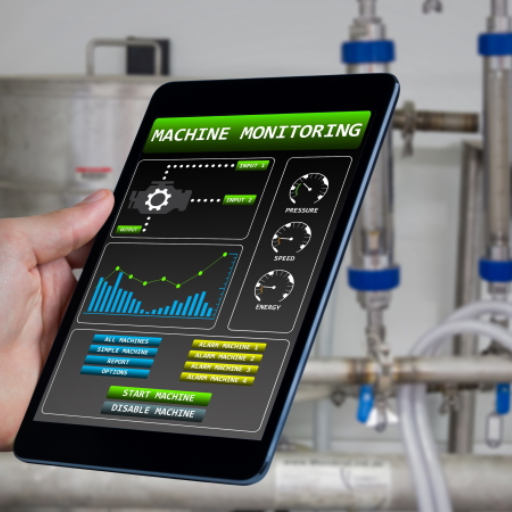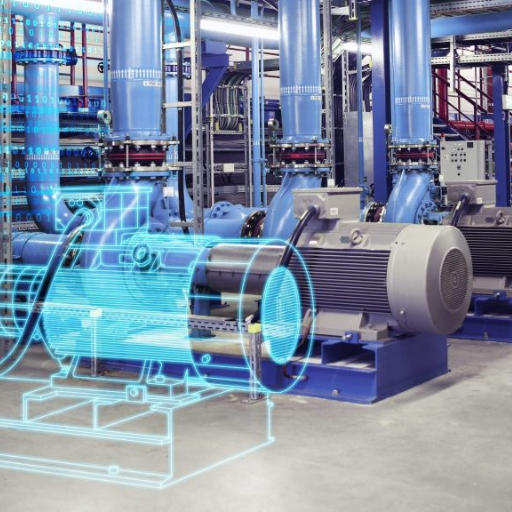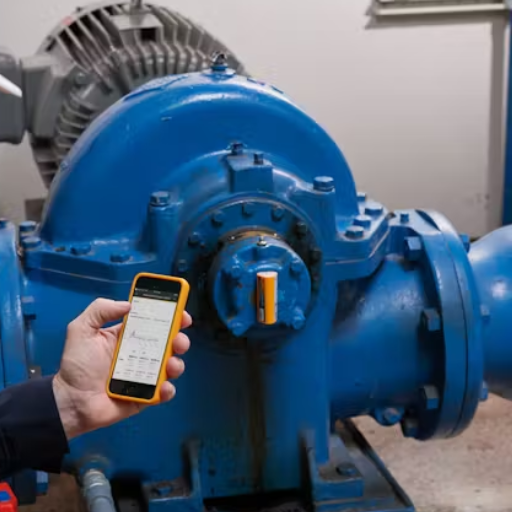For minimizing downtime and maximizing productivity, it is important to maintain optimal machinery performance in today’s industrial environment where the pace is fast. Online condition monitoring systems have emerged as an innovative technology that gives real-time information on machine health, thus enabling proactive maintenance as well as immediate interventions. This blog will discuss importance of these systems, their operation and various advantages that range from prolonging machinery life to cutting down running costs. Join us to explore a generic model of online condition monitoring and find out how employing this state-of-the-art technology can transform your approach to machine servicing.
How Does an Online Condition Monitoring System Work?

Image source: https://www.ptc.com/
More generally, an online condition monitoring system works by regularly obtaining information from multiple sensors attached to critical machinery parts, which measure the most important parameters as vibration, temperature, pressure and oil quality. This data is sent to an operation centre where it is analyzed using advanced algorithms. These algorithms help identify any differences between normal operations and potential problems at their early stages. These systems provide maintenance teams with actionable intelligence that allows them to carry out selective interventions which can avert unexpected breakdowns and ensure optimal performance of machinery.
Key Components of a Condition Monitoring System
- Sensors: Sensors are the most important tools in a condition monitoring system. Their role is to measure vital parameters, i.e., vibration, temperature, pressure, and oil quality. These must be resourceful sensors that give real-time data accurately and this is important for effective machine health monitoring and analysis.
- Data Acquisition System: This is a system which collects information from sensors and sends it to central monitoring platform. This hardware often involves signal conditioners and data loggers to ensure that it captures the appropriate information in order for it to be analyzed appropriately.
-
Centralized Monitoring Platform: It can be seen as the “brain” of the condition-monitoring-system. The centralized monitoring platform uses sophisticated algorithms and data processing software to analyze incoming data on the fly. It identifies patterns, trends or any other unexpected behaviors that may indicate potential problems. Then, the system will offer insights which are actionable as well as alert maintenance staff in order for them to prevent equipment breakdowns proactively while increasing performance.
Role of Vibration Sensors in Online Condition Monitoring
Online condition monitoring relies on vibration sensors that spot irregularities and differences in machine running patterns long before they snowball into substantial problems. The acceleration, velocity, or displacement are some of the issues measured by these sensors. By constantly watching those parameters, vibration sensors can detect initial signs of wear-and-tear, unbalance, misalignment and play. This data is used to reveal regularities and trends that help maintenance teams make interventions as scheduled rather than reactively. Thus, vibration sensors are indispensable when it comes to ensuring equipment durability; reducing downtime as well as maintaining operational efficiency.
Real-Time Data Collection and Analysis
Online condition monitoring (OCM) systems should collect and analyze data in real-time. Such a system must be able to monitor the working conditions of machines by constantly receiving data from different sensors such as vibration detectors, temperature gauges, and pressure sensors among others. The data is then sent to the central monitoring platform where it is analyzed right away. With new algorithms and machine learning approaches, the device can quickly detect irregular tendencies or deviations that are not normal.[1] Therefore, it helps prevent possible problems at an early stage before they become worse leading to break down of operations. This way, real time data collection and analysis contribute towards improving reliability of equipment while reducing unexpected downtimes and enhancing overall performance parameters.
Why is Online Vibration Monitoring Crucial for Machinery Health?

For the health of machines, online vibration monitoring is a must because it provides continuous, real-time machine condition status. With early detection of faults like unbalance, misalignment or wear and tear, it promotes proactive maintenance to reduce unexpected failures and costly downtimes. Besides increasing machinery life expectancy, this makes operations efficient and uninterrupted. Impeccable data accuracy as well as instant fault recognition makes online vibration monitoring crucial in attaining optimal operation of machinery thus enhancing its reliability.
Benefits of Condition Monitoring for Rotating Equipment
There are several critical benefits of condition monitoring for rotating equipment that improve productivity and its lifespan. First, it predicts failures and thus makes interventions before the failure happens thereby reducing maintenance costs. Secondly, it aids in avoiding accidents at work by identifying problems before they become dangerous. Moreover, this method increases reliability and performance of equipment ultimately leading to low down-time hence an increase in business efficiency. This approach helps organizations to manage their assets well, increase the equipment’s life span as well as realize significant savings on expenditure or cost.
Reducing Downtime with Predictive Maintenance
Predictive maintenance is a cost-saving effort that adopts preventive strategies to minimize downtime, hinged on advanced data analytics, machine learning and Internet of things (IoT) that help in anticipating equipment failures before the actual occurrence. In addition, predictive maintenance systems are designed to determine trends and identify patterns from historical and current data concerning equipment’s condition. This method lets service teams plan for repairs during idle periods as opposed to emergency repairs which in turn minimize unanticipated outages and maximize uptime. Predictive maintenance also helps companies manage their inventory levels effectively by reducing the costs associated with stock-outs or expediting due to breakdowns, thereby enhancing production efficiency. As a result, organizations embracing this technology could realize remarkable marginal gains in operational efficiency as well as substantial savings brought about by reduced downtimes.
Improving Asset Reliability and Performance
If operational efficiency is to be maintained and long-term success achieved, improving asset performance and reliability becomes a necessity. The development of a comprehensive maintenance program consisting of predictive and preventive maintenance is one of the main strategies aimed at enhancing reliability. Predictive maintenance employs data analytics and condition monitoring in order to predict possible failures, providing an opportunity for timely interventions that prevent unexpected breakdowns from happening. Preventive maintenance involves regular routine checks carried out to avoid problems before they happen.
Additionally, high-quality training should be invested in for the maintenance personnel so that they get equipped with skills and knowledge necessary for managing and maintaining equipment effectively. Furthermore, the use of advanced technologies such as Internet of Things (IoT), machine learning, Artificial Intelligence (AI) can greatly facilitate anomaly detection, performance data analysis and most importantly optimization of maintenance schedules.
Lastly, continuous monitoring will create a strong feedback loop which will help monitor the asset’s performance in relation to the designed maintenance strategy constantly leading to improvements where necessary. Through these approaches there can be significant improvement on asset life cycle, reliability as well as overall operational efficiency among companies.
What are the Key Features of an Effective Online Condition Monitoring System?

To make sure that assets are performing optimally and reliably, a good online condition monitoring system should have several key features. One important factor is real-time data acquisition that allows the system to continuously capture and analyze data coming from different sensors and equipment for determining the health and performance of assets instantly.
Another feature to consider is advanced analytics and diagnostics which rely on machine learning techniques as well as artificial intelligence algorithms in identifying patterns, predicting future problems as well as providing suggestions which can be acted upon. This enables pre-emptive maintenance, reducing unforeseen downtimes.
Remote accessibility is also an indispensable component, so that the cloud-based platforms can enable maintenance teams to monitor and control asset conditions irrespective of their geographical positions. In this case, it improves time to respond as well as flexibility.
There is need for integrating with other business systems including ERP (Enterprise Resource Planning) or EAM (Enterprise Asset Management) in order that data may flow seamlessly across these points thereby ensuring comprehensive management of assets. Finally, user-friendly interfaces comprising customizable dashboards plus reporting tools will simplify use by different stakeholders making it possible for them to access necessary information easily.
The final critical aspect in this regard is reliable alarm plus notification mechanisms capable of raising alerts on real-time basis whenever there are any abnormal conditions or threats of failures. The inclusion of these aspects will go a long way into improving operational efficiency, reliability and performance of assets using online condition monitoring systems.
Integration of Wireless Vibration Sensors
Its functionality is greatly improved and many advantages come with it when wireless vibrating sensors are integrated into an asset monitoring system. They can be easily installed because no extensive wiring is required, making them useful in new or existing installation of equipment. Moreover, the use of wireless sensors significantly lowers the costs associated with installation and maintenance. This enables ease of expansion and relocation, if necessary as the monitoring needs grow.
Wireless vibration sensors also facilitate real-time monitoring and data transmission that leads to current information about machine status being received by operators. This helps in early detection of abnormal vibrations which usually indicate mechanical problems like misalignments, unbalances or bearing failure chances. In addition, these sensors enable organizations to become proactive maintenance-wise thereby reducing unexpected downtimes and increasing equipment longevity.
Additionally, through cloud-based platform integration and advanced analytics tools, data collected from these wireless vibration sensors can link up seamlessly with other systems. This then allows wide data analysis and trend identification hence aiding in predictive maintenance strategies too. As a result companies are able to achieve optimized asset performance levels, increased reliability as well as improved efficiencies of operation.
Alert Systems for Immediate Response
Making sure that strong alarm systems are in place is of utmost importance to be able to act quickly whenever something goes wrong. These systems help the maintenance team to be alerted immediately through a variety of channels including SMS, email and mobile apps. By taking advantage of artificial intelligence and machine learning algorithms, these alert systems can determine how severe an issue is and also foresee any possible breakdowns thereby enabling corrective measures. Combining alert systems with wireless vibration sensors improves the benefit of live monitoring hence allowing for rapid response measures against mechanical damage as well as prevention of expensive downtimes.
Plantwide Condition Monitoring Capabilities
Plant-wide condition monitoring can involve integrating various sensors and systems to monitor the overall condition of machines and structures found in an industrial setting. Such systems provide a complete picture of the functioning of devices, including wireless vibration sensors, thermal imagers, and acoustic sensors. The information collected is sent to central analytics platforms where trends, anomalies, or predictive insights are processed and visualized using sophisticated algorithms. This method allows for constant monitoring thus enabling early detection of problems which improves reliability and efficiency of assets. Plant wide condition based maintenance ensures that there is prevention rather than intervention approaches leading to minimal down time and the highest productivity across all sections of the company.
How to Implement an Online Condition Monitoring Program?

Implementing an online condition monitoring program requires many steps:
- Evaluate Existing Requirements and Objectives: Understand, among other things, the aims of downtime reduction or machine improvement specifically.
- Choose Appropriate Sensors and Instruments: Have a blend of sensors such as wireless vibration sensors, thermal imagers and acoustic sensors that address the identified requirements.
- Deploy Sensors Strategically: Place them in particular points of important machines for comprehensive data collection.
- Link to Analytic Platforms: Create a single point system for collecting, processing and visualizing data. These algorithms should be sophisticated enough to detect patterns and exceptions.
- Train Staff: Ensure that the technicians have been trained on how to use the monitoring tools as well as understand what the results mean.
- Develop Reaction Protocols: Prepare an explicit strategy for alert response and predictive insight management.
- Continuous Review and Optimization: Regularly check performance of this system for any necessary adjustments towards improved efficiency and effectiveness
By following these steps, organizations can successfully implement an online condition monitoring program that enhances maintenance strategies and operational productivity.
Choosing the Right Monitoring Solution for Your Machinery
This is why it is crucial for you to choose the right monitoring solution for your machinery if you want to maximize its performance and minimize any downtime. Below are key considerations from top industry sources:
- Compatibility and Flexibility: Choose a system that is compatible with a wide range of machinery and can adapt to technological advances in the future for seamless integration and longevity.
- Real-Time Data and Analytics: Choose solutions that provide real-time monitoring and advanced analytics capabilities enabling immediate detection of potential problems and informed decision-making.
- Scalability: Select a scalable solution that can grow as your business grows, meaning the monitoring system should take in more data volume, additional equipment without any trade-offs on its performance.
- User-Friendly Interface: Systems must have intuitive user-friendly interfaces which reduce maintenance personnel’s learning curve making them utilize monitoring tools effectively.
- Vendor Support and Training: Consider solutions offered by vendors who offer robust customer support and training programs that are essential in successful implementation, troubleshooting.
Prioritizing these factors will help you select a monitoring system that suits your machinery it therefore enhances overall operational efficiency.
Setting Up Wireless Sensors for Condition Monitoring
There are different specific steps that must be followed to have effective and dependable wireless sensors for condition monitoring. The first thing you should do is to choose sensors that have compatibility with the machines in question as well as your monitoring needs. The positioning of sensors on machines is vital for obtaining meaningful data. Then configure them following the producers’ manual guidelines by making sure they are calibrated for optimum performance.
Afterwards, integrate the sensors into your monitoring system so that they can communicate seamlessly with the control units. Establish a reliable network link to facilitate real-time reception and analysis of information meant for limits triggering systems and alarms within the monitors software.
Finally, it is important that maintenance checks become regularly conducted on both sensors and monitoring systems to ensure precision and long life span. Consistent information from well-maintained devices allows proactive maintenance with reduced machine downtime. Therefore, by adhering to these steps, wireless sensors for condition monitoring can be effectively installed thus enhancing dependability and productivity of machinery operations.
Training Your Maintenance Team in Online Monitoring Technologies
To guarantee maximum gains of real-time data analytics and uptime of machines, it is vital that you coach your support workers on online monitoring technologies. To commence with, provide a comprehensive training to familiarize the team members with the basics of condition monitoring such as equipment types, their collected data, and how this information can be used for informed maintenance decisions.
There is a great need for hands-on activities. In this case, each member should have an opportunity to put his/her hands on these systems by installing sensors, adjusting tools’ calibration values and customizing software platforms. Also ensure that you include installation processes, interpretation of data and ways of effectively responding to alerts or alarms.
Use e learning platforms and other online materials alongside in-person courses. A number of leading websites provide instructive tutorials as well as webinars on condition monitoring and equipment management. In turn, personnel are encouraged to attend some of these courses in order to possess knowledge about recent technologies utilized in the field.
Further still; encourage continuous learning culture in your organization. Conduct periodic retraining sessions for your staff so as they will remained updated on new developments concerning online monitoring technologies available today and best practices adopted industry wide. With time this knowledge will help them understand how equipment failure can be predicted using these technologies thus enabling better management towards enhanced plant performance and economic benefits associated with increased efficiency and productivity throughout the entire process line.
What Common Faults Can be Detected with Vibration Monitoring?

Monitoring the vibrations of machine tools is an effective approach to identifying numerous commonly occurring machinery problems. Some common problems detected include:
- Imbalance: Inadequate distribution of mass on rotating parts, which eventually results in high vibration and potential damage.
- Misalignment: Wrong arrangement of machine parts that may result in increased wearing out as well as early failures.
- Bearing Faults: Vibration variations can indicate bearing defects such as fatigue, spalling and pitting
- Gear Wear: Abnormal vibrations may be due to broken teeth, surface defects or improper gear meshing
- Looseness: Parts that are not firmly fixed can cause excessive vibration and damage to the equipment.
- Resonance: Operating a machine at or near its natural frequency amplifies vibration that could lead to total failure.
By making use of vibration monitoring effectively prevents early detection of these faults leading to timely maintenance thus reducing risk of unexpected equipment downtime.
Identifying Bearing Faults and Their Impact on Machinery
Many faults can be detected in a bearing as such they have serious effects on the performance and lifespan of machines. These pitting, spalling or fatigue are common types of bearing faults that leads to irregular vibration patterns which can be picked through vibration monitoring techniques. When not attended in time these defects increases friction, excessive heat and eventually lead to bearing failure.
Bearing faults have major consequences on machinery. For example, defective bearings can cause other machine parts to wear out more quickly resulting in a chain of failures. This is accompanied by reduced equipment productivity and increased repair duration, leading to costly downtime. Additionally, undetected bearing faults may deteriorate into catastrophic breakdowns which could cause serious harm to the whole machine. Through the use of vibration monitoring, early identification of these faults enables precise maintenance interventions thereby maximizing the uptime and efficiency of the equipment.
Diagnosing Imbalances in Rotating Machinery
A careful diagnosis of rotating machinery disturbances is necessary to maintain operational efficiency and forestall damage. When the mass of a rotor is distributed unevenly around its axis of rotation, excessive vibration can occur as well as possible destructions. The following are the main steps in diagnosing such problems:
- Initial Inspection: Begin with a thorough visual inspection to check for any obvious issues, such as bent shafts or displaced components. Ensure that the machinery is clean because dirt and debris contribute to imbalance.
- Vibration Analysis: Use vibration sensors on critical machine areas to detect abnormal vibrations. Imbalances typically produce a specific vibration pattern at the rotational frequency.
- Balancing Equipment: Utilize balancing machines or software that calculates the imbalance in the rotor.These tools help in determining amount and location of the imbalance so that it can be rectified effectively.
- Corrective Measures: Once identified, correct the imbalance by adding or removing weight from the rotor. This process may involve attaching balance weights or machining material off specific areas.
- Routine Monitoring: Implement continuous vibration monitoring to detect any new imbalances early . Regularly schedule maintenance checks using vibration analysis tools to ensure long-term machine health and performance.
Therefore, when these steps are followed through , it makes it possible for us to diagnose and eliminate imbalances hence enhancing reliability and longevity of rotating machines.
Detecting Misalignments and Their Consequences
Misalignments in rotating machinery take place with regard to the centerlines of coupled components like shafts which are not co-linear. This may lead to significant consequences on the machine’s performance and its life span. These are the fundamental steps you should undertake to detect and correct misalignments:
- Use your eyes: Examine couplings, bearings, and seals for any visible signs of misalignments or wear patterns. These include uneven wear that indicates a system is out of alignment.
- Utilize Measuring Tools: Use precise measuring tools such as straight edges, dial indicators, laser alignment systems for aligning shafts. These instruments produce accurate information about relationships relating to parts connected together.
- Vibration Analysis: The presence of specific vibration frequency patterns can indicate that there is a misalignment in machines. Vibration analysis helps in determining the severity and type of angular or parallel misalignment.
- Temperature Monitoring: High temperatures at junction points signal misalignment, which can be identified using thermal imaging tools that reveal regions with more friction due to mal-positioning.
- Corrective Actions: In case they are discovered, these imperfections can be adjusted by shifting their positions about the items involved. Some examples include realigning motor with gear box brackets or repositioning shafts for better precision towards desired axis
- Regular Monitoring: Implement continuous monitoring systems to detect any future misalignments. Preventive maintenance procedures should also include scheduled alignments checks so as prevent serious alignment problems and keep machines running at best levels
The implications associated with ignoring such deviations consist of increased tear, loss in efficiency, intensified shaking, ultimately leading to breaking down before time thus undermining machinery components prematurely . Responding immediately to deviations will guarantee trustworthiness and durability of mechanisms you use.
Frequently Asked Questions (FAQs)
Q: What is an online condition monitoring system?
A: An online condition monitoring system continuously tracks the machine condition, providing real-time data to help prevent unexpected failures. It leverages condition monitoring tools to measure parameters like vibration and temperature to assess the health of critical equipment.
Q: How can IIoT improve machine condition monitoring?
A: Industrial Internet of Things (IIoT) enhances machine condition monitoring by connecting monitoring sensors to a network, making it easier to collect, analyze, and act on vibration data. This leads to more efficient fault detection and helps maintain the health of your assets.
Q: What are the benefits of using vibration analysis in condition monitoring?
A: Vibration analysis is essential in condition monitoring as it helps detect early signs of wear and tear, misalignment, or other issues. By monitoring vibration levels, you can perform timely maintenance and avoid costly downtime.
Q: What types of machinery can benefit from condition monitoring systems?
A: Condition monitoring systems are beneficial for various types of machinery, particularly critical equipment in industries such as manufacturing, power generation, and oil and gas. These systems ensure the reliability and longevity of the machine’s performance.
Q: How does condition-based monitoring work?
A: Condition-based monitoring uses real-time data to assess the health of equipment. Instead of following a fixed maintenance schedule, maintenance is performed based on the actual condition of the machine, optimizing repair costs and minimizing downtime.
Q: What is the role of diagnostics in online condition monitoring?
A: Diagnostics play a crucial role in online condition monitoring by analyzing data from monitoring equipment to identify potential machine faults. Advanced diagnostics can pinpoint the exact issue, enabling quicker repairs and improved machine uptime.
Q: Can online condition monitoring systems be used in Industry 4.0?
A: Yes, online condition monitoring systems are a vital component of Industry 4.0. They integrate with smart technologies to provide scalable and efficient monitoring solutions, leveraging IIoT to enhance overall machinery and operational performance.
Q: What monitoring equipment is typically used in condition monitoring services?
A: Condition monitoring services commonly use equipment like vibration sensors, temperature sensors, and power monitors. These tools provide comprehensive data on the machine’s condition, enabling effective condition-based maintenance strategies.
Q: How can I choose the right condition monitoring solution for my machinery?
A: To choose the right condition monitoring solution, consider factors like the criticality of your equipment, the types of faults you need to detect, and the integration capabilities with your existing systems. Solutions like the Acoem Master and System 1 Software offer robust features for various monitoring needs.
Q: Is wired vibration monitoring still relevant in a wireless world?
A: Yes, wired vibration monitoring remains relevant as it provides reliable data transmission, especially in environments where wireless signals may be compromised. However, organizations can also integrate wired systems with wireless solutions for comprehensive condition monitoring.






